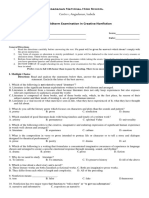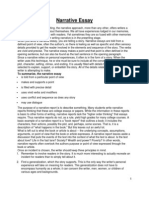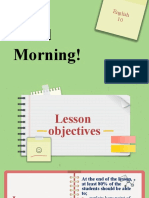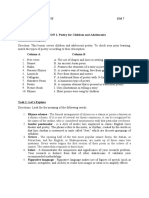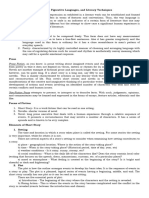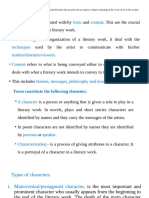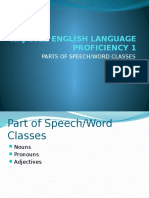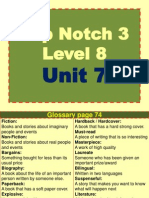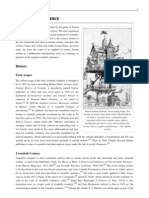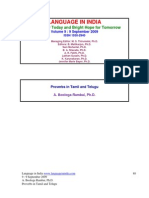Lga3101 Qna
Lga3101 Qna
Uploaded by
Eidda Abdul RahmanCopyright:
Available Formats
Lga3101 Qna
Lga3101 Qna
Uploaded by
Eidda Abdul RahmanOriginal Description:
Original Title
Copyright
Available Formats
Share this document
Did you find this document useful?
Is this content inappropriate?
Copyright:
Available Formats
Lga3101 Qna
Lga3101 Qna
Uploaded by
Eidda Abdul RahmanCopyright:
Available Formats
LGA3101 Q&A
N o t e b o o k : 2 PPG 05/11/2012 9:53 AM C re at e d : Suhaimi Shaarani A u t h o r: U p d at e d : 06/11/2012 12:08 AM
Describe the purpose of using literature in your English lessons. Literature Literature Literature Literature Literature is authentic material. encourages interaction. expands language awareness. educates the whole person. is motivating.
Explain briefly four factors that motivate pupils to read. Have a sense of control over their own lives. The classroom is organized and they know what to do. The pupils feel secure in an organized environment they can trust. Even with no adult in the room, the pupils know how to help others accomplish things. Have a sense of responsibility to get their assignments done. State and briefly explain four different types of non-fiction books. Narrative Writing Tells a true story about a person, event or place. Expository Writing To explain or inform a reader about a certain topic. Persuasive Writing Takes a position on an issue and argues for his or her side or against an opposing side. Descriptive Writing Employs all five senses to help the reader get a visual of what the writer is trying to describe. Literature Genres Non-Fiction narrative Non-Fiction : based on fact, tells a story Biography: a written account of another person's life Autobiography: written by oneself Fiction Drama: Stories in verse or prose- for theaterical Poetry: verse and rhythmic writing with imagery that evoked emotions Fantasy: forming of mental images, strange Fable: supernatural, narrated - useful truth Fairy Tales: magical, fairies - for children Science Fiction: potential science - actual or imagined Realistic fiction: can actually happen, true to real life Folklore: songs, myths, proverbs - mouth to mouth Historical Fiction: fictional characters with historical setting Horror: evokes feeling of dread and fear
State and briefly explain three different types of biographies. 1. Autobiography (Self written) A narrative account of an extended period of some person's life, written by, or presented as having been written by, that person; or the practice of writing such works. Autobiography differs from biography not only in its evidently more subjective narrative point of view but in its inconclusiveness: an autobiographer cannot recount her or his own death. 2. Biography (written by others) A narrative history of the life of some person; or the practice of writing such works. Most biographies provide an account of the life of a notable individual from birth to death, or in the case of living persons from birth to the time of writing; but some treat the connected lives of paired subjects or of groups (known as group biography); and since the late 20th century the term has been stretched to cover accounts of non-human subjects such as houses, cities, or commodities, in which case a biography really means an intimate or gossipy history. 3. Memoir (writer's experience) A narrative recollection of the writer's earlier experiences, especially those involving unusual people, places, or events. A memoir is commonly distinguished from an autobiography by its greater emphasis on other people or upon events such as war and travel experienced in common with others, and sometimes by its more episodic structure, which does not need to be tied to the personal development of the narrator; however, the terms are often still confounded. Memoirs are supposed to be non fictional. What factors would you consider when selecting a play or short story for primary pupils. expand awareness provide an enjoyable read that doesnt overly teach or moralize tell the truth embody quality have integrity show originality Briefly explain three characteristics of the following poems. acrostics Uses the letters in a topic word to begin each line. All lines of the poem should relate to or describe the poem Shines brightly Up in the sky Nice and warm on my skin haiku 3 short lines 1st line - 5 syllable 2nd line - 7 syllable 3rd line - 5 syllable Must paint a mental image The flightless bird hops Waddle waddle waddle flop And down it tumbles limerick a 5-line poem, funny, rhyme- aabba 1 couplet and one triplet Line 1: rhyme /a/ 3 beats
Line 2: rhyme Line 3: rhyme Line 4: rhyme Line 5: rhyme Contains hyperboles, Last line must be the
/a/ 3 beats /b/ 2 beats /b/ 2 beats /a/ 3 beats onomatopoeia, idioms, puns Punch Line
cinquain a class of poetic forms that employ a 5-line pattern. Earlier used to describe any five-line form, it now refers to one of several forms that are defined by specific rules and guidelines Listen... With faint dry sound, Like steps of passing ghosts, The leaves, frost-crisp'd, break from the trees And fall diamante A poem is the shape of a diamond. Each uses spesific types of words, like adjectives and ~ing words. It does not have to rhyme Day Bright, sunny Laughing, playing, doing Up in the east, down in the west Talking, resting, sleeping Quiet, dark Night
Briefly explain two reasons for using these poems in the primary classroom. Stimulates the imagination Has fun language, rhyme, rhythm and patterns Has big, clear print and pictures Is developmentally appropriate Keeps a childs attention Gets children involved in the story Has sensory appeal Discuss four important elements found in literary texts. The main idea of the work, or a specific message they author attempts to Theme : convey. Plot : What happens and why. Setting: The time, place, and the environment around the characters. Characters: The people who are used in the work, such as: protagonist, antagonist. Major characters and minor characters. Narrator: Who tells the story. It can be: First person narrator: The narrator is a usually a character in the work. Pronouns such as "I" and "we" are used. Found in autobiographies and some fiction. Second person narrator: When the narrator uses the pronoun "you." In effect, this comes across that the narrator is telling you the story. Third person narrator: when the narrator uses the pronouns "he," "she," or "they." The third person narrator is the most versatile because it can tell the story from any time and place. Style: The language of the work where it is modern, old, easy, or difficult. Also, the
techniques the author uses to convey his or her message. Symbols: Symbols represent things and ideas for something which they are not. For example, a character can be symbolic of a particular idea, or an object can be symbolic of a concept Identify and explain two different types of literature that can be used in the classroom. Provide two examples of each type. Picture books, including board books, concept books (teaching an alphabet or counting for example), pattern books, and wordless books. Traditional literature, including folktales, which convey the legends, customs, superstitions, and beliefs of people in past times. This genre can be further broken down into myths, fables, legends, and fairy tales. Fiction, including fantasy, realistic fiction, and historical fiction. Non-fiction. Biography and autobiography. Poetry and verse. Discuss how teachers can help pupils to overcome prejudice and bigotry through the learning of Literature. Use Multicultural Literature Understanding and respect for each childs cultural group identities Respect for and tolerance of cultural differences of gender, language, race, ethnicity, religion, region and disabilities Understanding of and respect for universal human rights and fundamental freedoms Preparation of children for responsible life in a free society Benefits: Children gain better understanding of people from other countries & ethnic backgrounds Increase childrens sensitivity to those who are different from themselves Improve their knowledge Able to share similarities and differences Improve their vocabulary development Fun for children to see same story theme varies from one country to another Historically in Ancient Greek libraries, bibliotherapy is known as The Healing Place of the Soul and The Medicine Chest for the Soul. Do you agree or disagree with the statement? Discuss. WHAT IS BIBLIOTHERAPY? Bibliotherapy is the practice of helping individuals grow and develop through books. Bibliotherapy as defined by the American Library Association is "the use of selected reading materials as therapeutic adjuncts in medicine and psychiatry; also, guidance in the solution of personal problems through directed reading." Many teachers practice bibliotherapy in some manner, often without giving their practice a formal name. However, effective follow-up activities, thoughtful questions, and focused discussion require that teachers are mindful about their use of books to address individual and group issues. Bibliotherapy may be used individually, with small groups, or even with an entire class, depending on the need. Teachers may also consider involving parents in the reading and follow-up activities. Bibliotherapy is a tool to be modified and adapted to a particular context. However, the process
always begins with identifying the need of the students and selecting appropriate reading material. Teachers should take care to ensure that the books are appropriate in terms of reading level, interest, and subject matter. It is essential that teachers read the entire text and consider if any subjects addressed might require parental input or consent. It may be helpful to compile a written bibliography or classroom library of titles about common topics for that grade level. Media specialists, librarians, and other grade-level teachers may be useful collaborators! Once titles have been selected, teachers should plan how and when reading will occur (individual/small group/read aloud) and what activities will help students reflect on the text, gain insight, and apply new understanding to their own situation. This process must be as carefully planned as any academic objective or students may not benefit fully from the experience! It is important to remember that bibliotherapy is not a cure-all, nor will it reach every student in the same manner. Instead, it is just another tool in a teachers box to deal with the varied emotional, behavioral, and social issues of her students.
Discuss the teachers role and the learners role in the teaching and learning of the literature component .
Forms of Poetry Lyrical Poetry Consists of Poem, sonnets or ode Expresses the thoughts and feelings of the poet Nowadays: Songs Ballads folk-song or orally transmitted poem direct and dramatic manner Local history / legends normally composed in Quatrains Sonnets A lyric poem of a single stanza - 14 lines Italian or Petrarchan sonnets - One octave and One sestet - abbaabba and cdecde or cdccdc Shakespearean or English sonnets - 3 quatrains and 1 couplet Epics Long narrative poem elevated style hero-centered (semi-divine) historical legends Haiku 3 short lines 1st line - 5 syllable 2nd line - 7 syllable 3rd line - 5 syllable Must paint a mental image
The flightless bird hops
Waddle waddle waddle flop And down it tumbles
Limerick a 5-line poem, funny, rhyme- aabba 1 couplet and one triplet Line 1: rhyme /a/ 3 beats Line 2: rhyme /a/ 3 beats Line 3: rhyme /b/ 2 beats Line 4: rhyme /b/ 2 beats Line 5: rhyme /a/ 3 beats Contains hyperboles, onomatopoeia, idioms, puns Last line must be the Punch Line Poetic Devices Alliteration - The repetition of a beginning sound Allusion - a casual reference to someone or something that paints a mental picture Analogy - Comparisons of two things : explaining one to show the similarities Caesura - pausing or stopping within a line of poetry, by punctuation Enjambement - the continuation of thought from one line to another without punctuation Hyperbole - extreme exaggeration for effect Metaphor - comparison of two unlike things. eg: Clouds are ships in full sail Metonym - substitution of a word for another that is closely associated. eg: White House to the President Onomatopoeia - the sound things make Oxymoron - use of contradictory items for effect. eg: Freezing fires of hell Personification - giving human traits to non-human things. eg: The sun smiles Simile - comparison of two unlikely things as one is like the other Symbol - something representing other than itself. eg: Dove-Peace Elegy - poem of extreme sorrow (lament) Free Verse - poem without any rhymes or rhythm imagery - use of words to create mental picture mood - the emotional effect Theme - the controlling idea
You might also like
- Nabokov - Spring in FialtaDocument17 pagesNabokov - Spring in Fialtatheintrepiddodger100% (1)
- Borer 2 Structuring Sense: "The Normal Course of Events"Document417 pagesBorer 2 Structuring Sense: "The Normal Course of Events"Anabella100% (1)
- MIDTERM EXAMINATIOin CN With Answer KeyDocument6 pagesMIDTERM EXAMINATIOin CN With Answer KeyAlyanna Jovido89% (9)
- Lesson 1Document26 pagesLesson 1Enchik MazliNo ratings yet
- Literatujpre AssingmDocument13 pagesLiteratujpre AssingmJP7090No ratings yet
- Exam Note On Literature Yr 7, Paper 1Document44 pagesExam Note On Literature Yr 7, Paper 1samuelbolalawalo50No ratings yet
- LiteratureDocument1 pageLiteratureMerve KilicNo ratings yet
- Childlit ReviewerDocument7 pagesChildlit ReviewerJohn Ray Felix100% (1)
- Module 1 - Philippine LiteratureDocument11 pagesModule 1 - Philippine LiteratureJennifer Cortez TanNo ratings yet
- Eng 48 Midterm ModuleDocument9 pagesEng 48 Midterm ModuleMonica Benitez RicoNo ratings yet
- Greatbooks PrelimDocument3 pagesGreatbooks PrelimdodakomataNo ratings yet
- Reading Assignment 1Document2 pagesReading Assignment 1ZeusNo ratings yet
- Storytelling Reading MaterialsDocument29 pagesStorytelling Reading MaterialsDimas Farayndra PranidhanaNo ratings yet
- English - 4 - Module - 2 Notes (FLVS)Document19 pagesEnglish - 4 - Module - 2 Notes (FLVS)yeezyyeezymaxbeezyNo ratings yet
- Narrative EssayDocument4 pagesNarrative EssaySzalbiah IszmailNo ratings yet
- AP English LiteratureDocument8 pagesAP English LiteratureArianM GRuizNo ratings yet
- Creative Fiction q1 Learning Package Week 5-6-Fbc12Document7 pagesCreative Fiction q1 Learning Package Week 5-6-Fbc12Princes BaccayNo ratings yet
- Week 2 LITERATURE AND LANGUAGE TEACHINGDocument27 pagesWeek 2 LITERATURE AND LANGUAGE TEACHINGemirtas0411No ratings yet
- 2011 Writing About LiteratureDocument70 pages2011 Writing About LiteratureHà VyNo ratings yet
- Self-Directed Learning Activity Sheet in Creative NonfictionDocument5 pagesSelf-Directed Learning Activity Sheet in Creative Nonfictionsuper nova100% (2)
- Course Outline MC Elt 4Document7 pagesCourse Outline MC Elt 4Rochelle RamosNo ratings yet
- Literature Activity1Document11 pagesLiterature Activity1Lesly Ann De GuzmanNo ratings yet
- LITERATUREDocument7 pagesLITERATUREmilembefunga08No ratings yet
- PHILIPPINE LitDocument35 pagesPHILIPPINE LitBlack BullNo ratings yet
- 21st CenturyDocument18 pages21st CenturykekoacybelleNo ratings yet
- Q3-WEEK3 Analyze-Literature-as-a-Mirror-to-a-Shared-Heritage-of-People-with-Diverse-BackgroundsDocument27 pagesQ3-WEEK3 Analyze-Literature-as-a-Mirror-to-a-Shared-Heritage-of-People-with-Diverse-Backgroundsdanielwong88No ratings yet
- Unit I SY 2023 24Document9 pagesUnit I SY 2023 24ljndeleonNo ratings yet
- Literary Devices Keesh Ppt.Document49 pagesLiterary Devices Keesh Ppt.Irithel LeoNo ratings yet
- Reviewer in English 7 OdlDocument3 pagesReviewer in English 7 Odledr3r4erwrwtfrteNo ratings yet
- World Literature: Prepared byDocument22 pagesWorld Literature: Prepared byLJ MermidaNo ratings yet
- Week 1 and 2 LessonsDocument8 pagesWeek 1 and 2 LessonsSalve Maria CardenasNo ratings yet
- Em 7 FinalsDocument3 pagesEm 7 FinalsTaehyung Kim100% (1)
- English ReviewerDocument6 pagesEnglish Reviewerdalialia136iNo ratings yet
- What Is Literature?: Oral or Traditional Literature Has Some Form of Stories Often Told by Word of MouthDocument7 pagesWhat Is Literature?: Oral or Traditional Literature Has Some Form of Stories Often Told by Word of MouthHadjer TalbiNo ratings yet
- 2nd Quarter LESSON 2Document7 pages2nd Quarter LESSON 2Salve BayaniNo ratings yet
- 2 Introduction To LiteratureDocument82 pages2 Introduction To LiteraturenasankumwilliamNo ratings yet
- CORE 001 3rd Quarter - Lesson 1Document7 pagesCORE 001 3rd Quarter - Lesson 1NatsumiGraceNo ratings yet
- Extensive Reading Test: The Good Immigrant's Selected StoriesDocument8 pagesExtensive Reading Test: The Good Immigrant's Selected StoriesVicente Oyarzun CartagenaNo ratings yet
- Time TableDocument117 pagesTime TableSalve Maria CardenasNo ratings yet
- f3&4 English Books Analysis NewDocument211 pagesf3&4 English Books Analysis NewJOHNNo ratings yet
- Life EAP Level 6 Listening U1 NotesDocument3 pagesLife EAP Level 6 Listening U1 NotesOsama CanaanNo ratings yet
- Bernardo College: Submmited byDocument17 pagesBernardo College: Submmited bylaiza jane blandoNo ratings yet
- Philippine Literature in English: Learning ModuleDocument16 pagesPhilippine Literature in English: Learning ModuleKris Jan Cauntic100% (1)
- Prose Teaching: Prepared By: Dr. Geetanjali SharmaDocument29 pagesProse Teaching: Prepared By: Dr. Geetanjali SharmaKaushal DivyeshNo ratings yet
- World Literature Week 1Document12 pagesWorld Literature Week 1Michaels CulturaNo ratings yet
- Literature ModuleDocument40 pagesLiterature ModuleCesarNo ratings yet
- Two Kinds of Literary DevicesDocument8 pagesTwo Kinds of Literary DevicesConje JessaNo ratings yet
- Philippines ASEAN Literature Philippine Literature: EnvironmentDocument7 pagesPhilippines ASEAN Literature Philippine Literature: EnvironmentBlack BullNo ratings yet
- Week 1 IntroductionDocument30 pagesWeek 1 IntroductionNur Hanna Adriana100% (1)
- Introduction To Literature Track Chages Accepted PDFDocument77 pagesIntroduction To Literature Track Chages Accepted PDFAlinafe ChakondaNo ratings yet
- F3&4 Literature in EnglishDocument220 pagesF3&4 Literature in EnglishJOHNNo ratings yet
- PIDO Lit 202Document18 pagesPIDO Lit 202Mariter PidoNo ratings yet
- SCIENCEDocument21 pagesSCIENCEbas.boeve2No ratings yet
- Makalah Literature Kel 2Document12 pagesMakalah Literature Kel 2Silvi PratiwiNo ratings yet
- Weeks 1 and 2 NotesDocument7 pagesWeeks 1 and 2 Notesjohn jake roxasNo ratings yet
- Humms 06 - Module 2Document9 pagesHumms 06 - Module 2pechiecabilesNo ratings yet
- Nov 14 To Nov 18 Types and Features of Prose and PoetryDocument25 pagesNov 14 To Nov 18 Types and Features of Prose and PoetryGeorge Maguale LauderezNo ratings yet
- summaryDocument4 pagessummaryrayan.azeezNo ratings yet
- Egt 05213 LiteratureDocument31 pagesEgt 05213 Literatureoswardmathias006No ratings yet
- Soclit WK 1Document42 pagesSoclit WK 1Shiella Heart MalanaNo ratings yet
- Basic Textual and Contextual Reading Approach in The Study and Appreciation of LiteratureDocument60 pagesBasic Textual and Contextual Reading Approach in The Study and Appreciation of Literaturenathan casinaoNo ratings yet
- Ebook Pandai Cakap v1.0Document20 pagesEbook Pandai Cakap v1.0Eidda Abdul RahmanNo ratings yet
- Before During and After Reading ActivitiesDocument41 pagesBefore During and After Reading ActivitiesEidda Abdul RahmanNo ratings yet
- IntegrationDocument15 pagesIntegrationEidda Abdul RahmanNo ratings yet
- English Year 3 KSSRDocument11 pagesEnglish Year 3 KSSRevdreyNo ratings yet
- Mid Year Exam English Year 3Document5 pagesMid Year Exam English Year 3Ricorian JdtNo ratings yet
- Section CDocument2 pagesSection CEidda Abdul RahmanNo ratings yet
- Prepositions of PlaceDocument3 pagesPrepositions of PlaceEidda Abdul RahmanNo ratings yet
- Lga 3101 Selection Criteria of TextsDocument8 pagesLga 3101 Selection Criteria of TextsEidda Abdul RahmanNo ratings yet
- Exam Q's English 2010Document4 pagesExam Q's English 2010Eidda Abdul RahmanNo ratings yet
- June3 English KSSR OverviewDocument21 pagesJune3 English KSSR OverviewEidda Abdul RahmanNo ratings yet
- Short Story ElementsDocument34 pagesShort Story Elementsacheron_pNo ratings yet
- - - newPractical Chinese Reader WORKb Volume 1 NPCR练习册第一课到第九课练习题答案Lessons 1-8)Document221 pages- - newPractical Chinese Reader WORKb Volume 1 NPCR练习册第一课到第九课练习题答案Lessons 1-8)Santé Kine Yoga-thérapieNo ratings yet
- ScriptDocument9 pagesScriptAnonymousNo ratings yet
- Waj 3022 English Language Proficiency 1Document18 pagesWaj 3022 English Language Proficiency 1nuranis nabilahNo ratings yet
- Racial Discrimination Potrayed in FlanneryDocument97 pagesRacial Discrimination Potrayed in FlanneryelrsNo ratings yet
- Islcollective Worksheets Elementary A1 Preintermediate A2 Intermediate b1 Kindergarten Elementary School High School Wri 22831510917ffc1be92 74334755Document3 pagesIslcollective Worksheets Elementary A1 Preintermediate A2 Intermediate b1 Kindergarten Elementary School High School Wri 22831510917ffc1be92 74334755Vendula MališováNo ratings yet
- The Acquisition of SemanticsDocument8 pagesThe Acquisition of SemanticsEmily LuNo ratings yet
- Unit 7 Noun ClauseDocument101 pagesUnit 7 Noun ClauseMs. Yvonne Campbell50% (2)
- Using Indirect SpeechDocument11 pagesUsing Indirect SpeechGeorge PoroNo ratings yet
- There Is There Are - ExercisesDocument4 pagesThere Is There Are - ExercisesAnonymous c1nF8ANo ratings yet
- The NecklaceDocument10 pagesThe Necklaceapi-251887521No ratings yet
- Writing Descriptive TextDocument11 pagesWriting Descriptive TextTuan Henry R Wed100% (1)
- Scientific RomanceDocument5 pagesScientific Romancewmturner72No ratings yet
- PersentasiDocument8 pagesPersentasiNamaaneitusiape Masyaalah IlanglagiNo ratings yet
- Unit 1 Activities - Philippine LiteratureDocument3 pagesUnit 1 Activities - Philippine LiteratureKynneza Unique100% (3)
- Writing Portfolio 2 - Unit 3 - PRESENT SIMPLE Connectors - But-And-becauseDocument40 pagesWriting Portfolio 2 - Unit 3 - PRESENT SIMPLE Connectors - But-And-becausepaula cerazo lazaNo ratings yet
- Gabriel Garcia MarquezDocument6 pagesGabriel Garcia MarquezAndres KmiloNo ratings yet
- Tamil Telugu ProverbsDocument8 pagesTamil Telugu ProverbsKeerthanasudarshanNo ratings yet
- The Selfish Giant 3Document21 pagesThe Selfish Giant 3Sujatha Menon100% (1)
- ParaphrasingDocument42 pagesParaphrasingDayittohin Jahid100% (4)
- CHA - Creative Wrting - QuestionnaireDocument16 pagesCHA - Creative Wrting - QuestionnaireCzarina SarcedaNo ratings yet
- Romeo & JulietDocument2 pagesRomeo & JulietaaNo ratings yet
- 15 Relative ClausesDocument2 pages15 Relative ClausesFikru0No ratings yet
- Madhyamik/Higher Secondary English Grammar For 2015 Prepared by Taibur Rahaman (B.Ed, M.A in English, B.A in English)Document4 pagesMadhyamik/Higher Secondary English Grammar For 2015 Prepared by Taibur Rahaman (B.Ed, M.A in English, B.A in English)Taibur RahamanNo ratings yet
- Poetic Devices 10Document3 pagesPoetic Devices 10api-239280560No ratings yet
- 30 PDFDocument223 pages30 PDFSripad PanyamNo ratings yet
- Quebec LiteratureDocument5 pagesQuebec LiteratureJose AgurtoNo ratings yet


